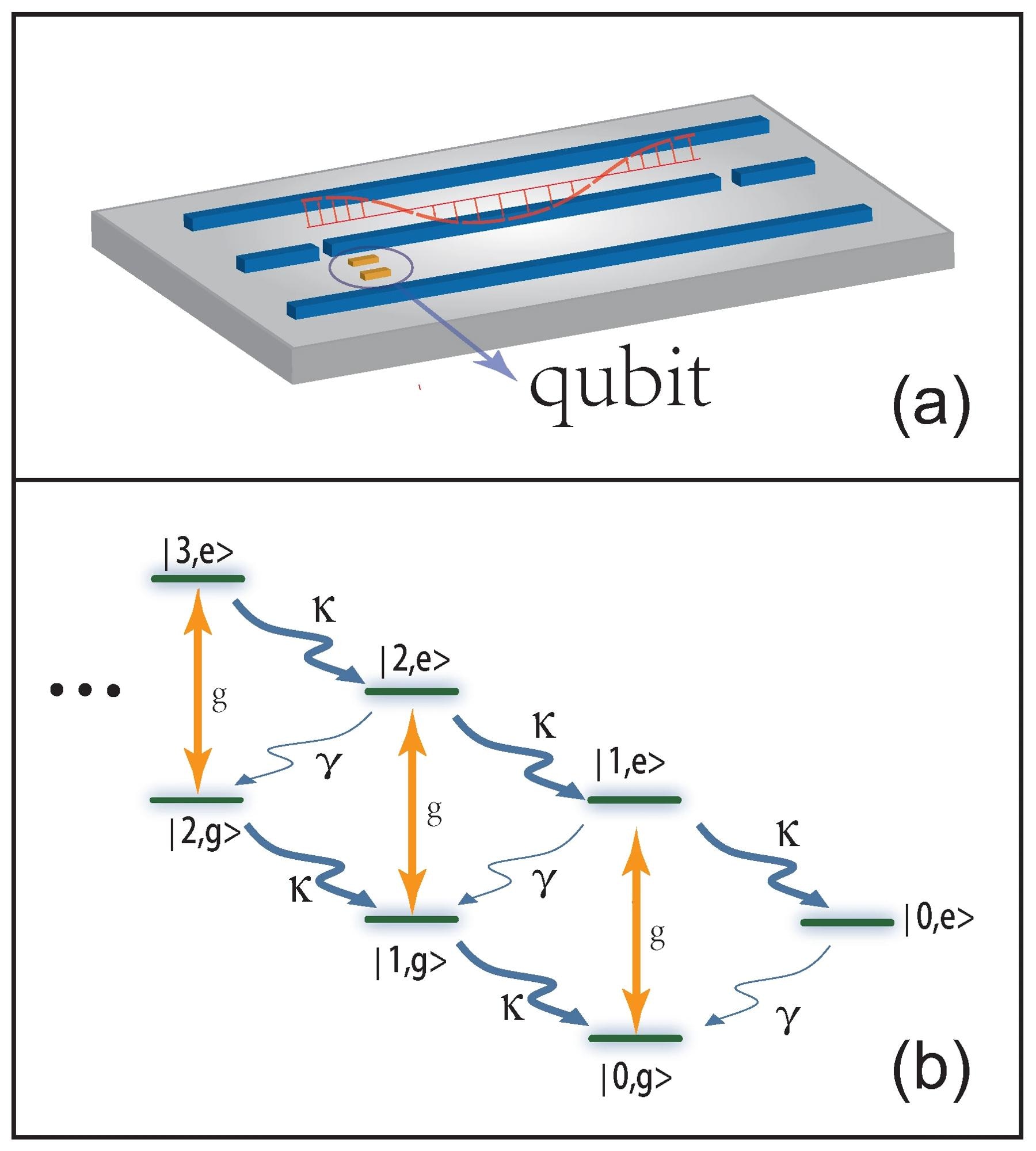In an article recently published in the journal Photonics, researchers explored the photon antibunching effect in the context of the anti-Jaynes-Cummings (anti-JC) model.
 (a) Schematic of a superconducting qubit interacting with the fundamental mode electromagnetic field confined within a transmission line resonator. (b) Energy level structure of the system. Image Credit: https://www.mdpi.com/2304-6732/11/4/369
(a) Schematic of a superconducting qubit interacting with the fundamental mode electromagnetic field confined within a transmission line resonator. (b) Energy level structure of the system. Image Credit: https://www.mdpi.com/2304-6732/11/4/369
Importance of Single Photon Sources
Quantum phenomena such as wave-particle duality and entanglement exist only in the quantum realm owing to the major differences between the classical world and the quantum world. This distinction necessitates quantum sources for applications in quantum precision measurements, quantum cryptography, and quantum networks.
Photons, due to their ability to integrate seamlessly with existing quantum systems, their high velocity, and minimal environmental interaction, are ideal quantum sources. Single-photon sources, in particular, are vital to quantum information technology, serving as crucial sources of nonclassical radiation.
The unique behavior of single-photon sources, characterized by the antibunching effect, ensures that photons are emitted individually. Various methods have been developed for generating single photons, including the photon blockade effect and pulsed excitation of a two-level quantum emitter.
As such, ongoing developments in single-photon source technology are foundational, enabling breakthroughs in quantum computing and secure communications that were once beyond reach.
Role of the JC Model
The JC model has been extensively utilized to investigate phenomena such as the photon antibunching effect and quantum entanglement. In this framework, a two-level emitter is coupled with a single-mode light field. The model is also instrumental in generating large average photon numbers and creating single-photon sources of high purity via the photon blockade effect.
Furthermore, by modulating the transition frequency of a two-level system, the anti-JC terms can be improved. This modulation allows the generation of a single photon while simultaneously exciting an atom in a vacuum—though these phenomena are not captured in the traditional JC model due to constraints of energy conservation.
Within a cavity, the average number of photons tends to increase due to the interactions between the system and its environment, leading to super-Poissonian quantum statistics of the field. Conversely, the anti-JC model demonstrates the photon antibunching effect under specific initial conditions, which includes preventing cavity leakage and atomic decay.
Considering the cavity decay is crucial to enable the intracavity photon emission for developing an anti-JC model-based single-photon source for practical applications.
The Study
In this study, researchers proposed that the anti-JC model can induce an effective photon antibunching effect when it is subjected to powerful cavity dissipation. This antibunching effect was referred to as dissipation-induced blockade, similar to the photon blockade caused due to robust photon-photon interaction.
The objective of the study was to investigate the light field's quantum statistics in an anti-JC model considering cavity leakage and atomic decay. In this work, the anti-JC model's physical configuration was a transmission line resonator connected to superconducting qubits.
Specifically, the physical model comprised a superconducting qubit interacting with the fundamental mode that was confined to the resonator. The coupling strength (g) in the model was modulated over time by regulating the magnetic flux change.
The Hamiltonian for the anti-Jaynes-Cummings model was derived using the rotating wave approximation in the interaction picture. This was done with reference to a specific frequency and under the assumption that the counter-rotating term in the Rabi interaction becomes resonant.
Assuming weak coupling modulation and a low-quality cavity, both the average photon number of the light field and the zero-time-delay second-order correlation function were analytically derived from the master equation for the density matrix. Based on these calculations, optimal parameters were determined to achieve pronounced photon antibunching.
Significance of the Work
This research demonstrated that a minimal coupling strength, coupled with the lowest decay rate of a qubit and a high photon decay rate, effectively facilitates robust photon antibunching within the system. Specifically, the condition g(2)(0) < g(2)(τ), indicative of photon antibunching, was only satisfied under the optimal condition of Δ = 0, where Δ = ωc – ωs represents the detuning between the transition frequency of the superconducting qubit and the fundamental mode frequency of the transmission line resonator.
However, the condition g(2)(0) < 1 was satisfied across all parameters, indicating that this condition is not a prerequisite for antibunching in the anti-JC model. Under the optimal conditions for antibunching, the average photon number reached its peak value. In this model, the observed photon blockade phenomenon was primarily due to the significant linear dissipation of the cavity mode rather than nonlinear dissipation.
Consequently, the photon blockade observed in this study differs from the conventional photon blockade caused by an anharmonic eigen-energy level structure in strongly nonlinear quantum optics systems.
In summary, the results highlight a novel type of photon blockade, termed dissipation-induced photon blockade, distinct from the traditional effect driven by strong photon-photon interactions. The anti-JC model achieves photon blockade with only weak nonlinearity, producing photon flux with high purity and a substantial average photon number. Therefore, this model shows promising potential for developing single-photon sources that offer both excellent photon number and purity.
Journal Reference
Huang, B., Li, C., Fan, B., Duan, Z. (2024). Dissipation-Induced Photon Blockade in the Anti-Jaynes–Cummings Model. Photonics, 11(4), 369. https://doi.org/10.3390/photonics11040369, https://www.mdpi.com/2304-6732/11/4/369
Disclaimer: The views expressed here are those of the author expressed in their private capacity and do not necessarily represent the views of AZoM.com Limited T/A AZoNetwork the owner and operator of this website. This disclaimer forms part of the Terms and conditions of use of this website.